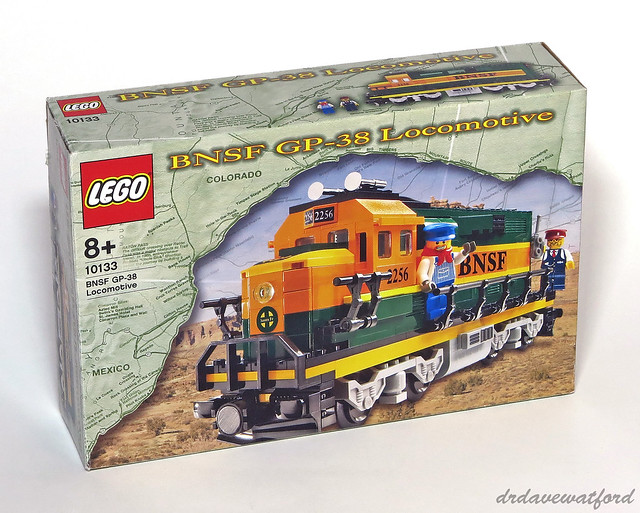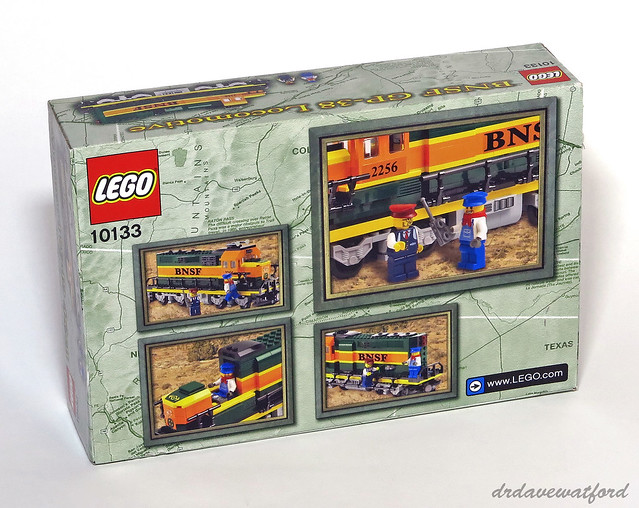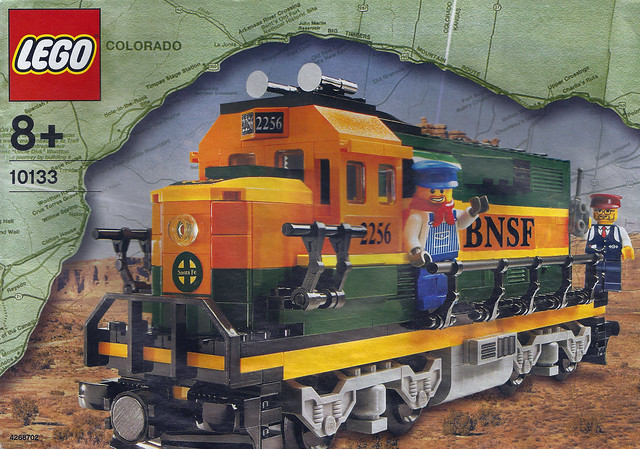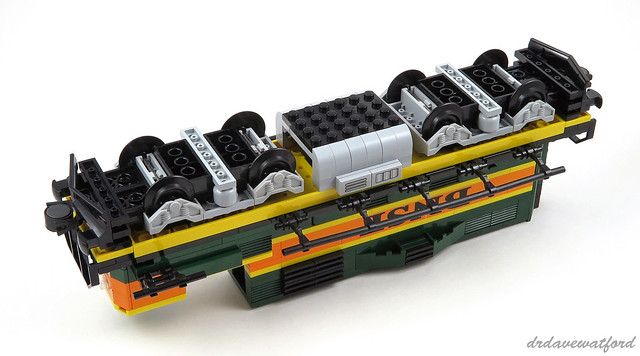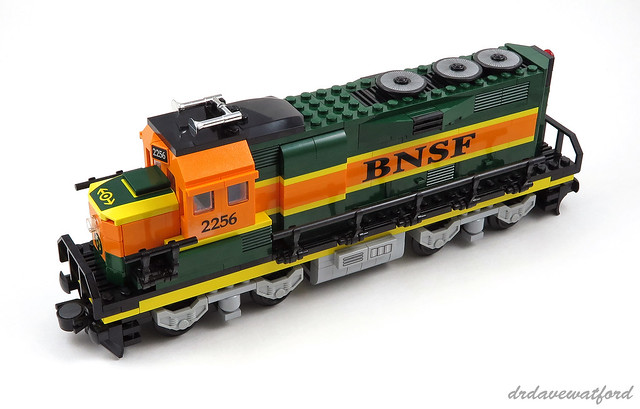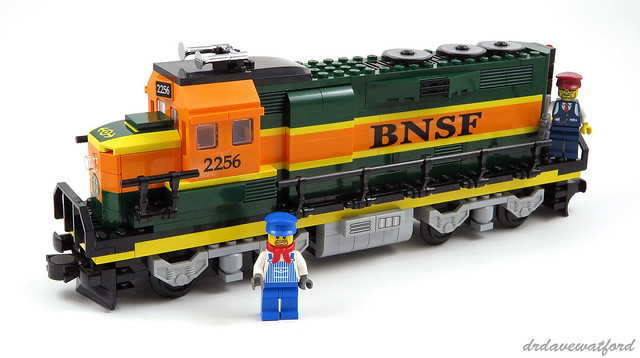One of the cool things about my ongoing MOC City Layout project is that it features two loops of old-style LEGO 9V track, thus providing me with the perfect excuse to dig out and revisit some of my favourite LEGO 9V trains. After all, I've been accumulating LEGO trains for years - one of the first sets that I ever owned was Set 171 Train Set without Motor - and my love of LEGO trains was one of the main reasons that I embarked upon on my LEGO City project in the first place.
Anyway, having recently finished installing the upper track loop of my city, I decided that I'd mark the milestone by building a classic LEGO 9V train and use it to test the newly-laid 9V track. But which train to choose? Well, if we're talking classic 9V trains then many fans probably wouldn't look beyond the coveted and much-loved Set 10020 Santa Fe Super Chief, which I previously posted about here and here and also wrote about in the first ever issue of Bricks Magazine. Being a master contrarian, however, I thought that the Super Chief would be too obvious, so I've therefore decided instead to tackle the Super Chief's less glamorous sibling, Set 10133 Burlington Northern Santa Fe Locomotive, or BNSF for short.
Set 10133 was released back in 2005, three years on from the Super Chief, but the two set boxes nevertheless carry the same branding and background artwork featuring a map of part of the Santa Fe railroad which runs from New Mexico to Colorado and into Kansas. The front of the box (above) also features a cutaway showing a photograph of barren desert terrain superimposed with an image of the completed BNSF model plus minifigures, while the back of the box (below) is dominated by a number of boxouts which provide some alternate views of the set contents.
The box is designed to be opened via a couple of thumb tabs. My copy of the set was pre-owned so I don't know how many bags of elements it contained when new; I can't provide you with a scan of the set's single sticker sheet either as the stickers had already been applied to the bricks in my copy of the set, but thanks to the wonders of Bricklink you can see an image of the unused sticker sheet here. The set contains a single instruction booklet, the front cover of which (below) carries the same imagery as the front of the box. The booklet is 56 pages long, and unusually there's not a single advertisement or other distraction - the building guide occupies every single page apart from the front cover.
The set contains two minifigures - Conductor Charlie and Engineer Max. Conductor Charlie (below, left) can be found in a total of six sets including this one. His torso print, featuring a dark blue waistcoat complete with a fob watch, is exclusive to this minifigure but his unprinted dark blue legs, head print and dark red hat can be found as a constituent part of many other minifigures. Engineer Max (below, right) appears in just four sets. The combination of his white arms, old dark grey hands and a torso print featuring blue striped overalls is exclusive to the minifigure, although his blue hat, red bandana and head print can all be readily found elsewhere.
You can see a rear view of the two minifigures minus their hats below. Neither Charlie nor Max has a backprinted head or a backprinted torso so there's not much of interest to see here
The BNSF locomotive is constructed on a yellow 6 x 28 train base which is exclusive to the set. The build starts with the placement of a black 1 x 6 train wagon end at both ends of the train base, while railings consisting of 19L rigid hoses are attached on either side. The body of the locomotive is then constructed, initially from a variety of dark green elements including 1 x 3 and 1 x 6 bricks, 1 x 8 plates, modified 1 x 2 bricks with grille, and left and right 1 x 3 x 1 doors, all of which are unique to the set in this colour. Yellow plates and orange bricks and plates are layered on top, after which we're back on to dark green for the roof of the locomotive which features yet more rare dark green elements including modified 2 x 2 bricks with a curved top and 2 top studs, left and right 3 x 2 wedges, and a 4 x 6 plate, none of which had been seen before in dark green prior to the release of this set.
The tapered front and rear of the locomotive are fashioned in dark green, yellow and orange using SNOT techniques; once again we see the appearance of elements such as dark green 45 degree 2 x 4 slopes which were unique to the set at the time of its release. An orange Technic 1 x 2 brick with a hole, which had previously only appeared in two sets, is placed at the front of the locomotive, and a trans-clear 1 x 1 round plate is inserted into the hole as a headlight. A dark bluish grey printed 1 x 4 tile is used to represent the control panel in the driver's cab. Large stickers provide the 'BNSF' lettering which runs along both sides of the body. These stickers are STAMPs, i.e. they traverse multiple elements; this practice leads to difficulties in terms of dissassembling models when you're done with them and also compromises the longevity of the stickers themselves, so we should definitely be thankful that LEGO have largely stopped using stickers in this way over recent years.
With the superstructure now largely complete it's time to get to work on the structures underneath the train base (below) including the wheel assemblies, or bogies if you prefer. These feature the use of unprinted light bluish grey minifigure heads which had only previously appeared in a total of 4 sets. Each completed wheel assembly clicks into a hole on the underside of the train base by way of a 5mm pin on the top of a train bogie plate; this attachment allows limited horizontal rotation sufficient to enable the locomotive to successfully negotiate curved track sections. I believe that the structure sandwiched between the wheel assemblies is supposed to represent a fuel tank; the tiles on either side of it are stickered rather than printed. Both wheel assemblies feature a standard magnetic coupling for attachment to rolling stock, another locomotive or a B unit.
With the bogies and fuel tank assembled and attached, all that's left to do is complete the driver's cab and add a couple of final details. STAMPs once again feature, specifically the unit number on either side of the cab. The orange 30 degree 1 x 1 x 2/3 slopes, a.k.a. cheese slopes, which protrude from the front of the cab are also stickered with the unit number. The cab incorporates a number of rare orange elements; the six 1 x 2 x 2 plane windows remain unique to the set to this day, while other elements including 1 x 3 plates, modified 1 x 1 bricks with headlight, modified 1 x 2 plates with door rail and 45 degree 2 x 4 slopes have to date appeared in just 8 sets or less in this colour.
A couple of uncommon chrome silver car air horns are mounted on the roof of the cab, while further back three stickered black Technic 3 x 3 discs are mounted on top of the body towards the rear; I believe that these are supposed to represent cooling fans. In addition to their appearance in this set, these stickered Technic discs have also been utilised in Set 10020 Santa Fe Super Chief plus the more recent Set 10219 Maersk Train, both of which are, like the BNSF locomotive, also diesels.
You can see the finished build complete with minifigures in the picture below. While not as sleek or elegant as the Super Chief, I can't help but love the eye-catching colour scheme of the BNSF locomotive. It's also worth noting that the model is a pretty respectable representation of the real train - you can see a picture of the actual BNSF unit 2256 here.
In addition to its aesthetic merits, this set is also notable from the perspective of the elements that it includes. Not only was it one of the first sets to include dark green elements in any real quantity, but it was also one of the very first sets to include the now-ubiquitous cheese slope. Furthermore, as previously described, the BNSF locomotive incorporates loads of rare elements, some of which continue to be unique to the set more than ten years after its release.
The BNSF locomotive might not be as celebrated as the Super Chief, but it's still pretty collectable. Retailing for just £24.99 / US$40.00 at the time of its release, you'll now need to stump up well over £200 / US$300 for a sealed copy on Bricklink; I was lucky enough to pick up my used, boxed example back in early 2010 for a little over £50 plus shipping, but it would set me back around three times as much to buy it in the same condition now.

